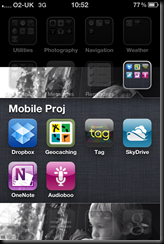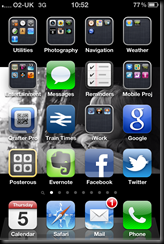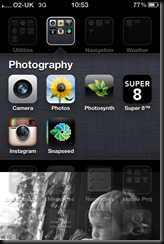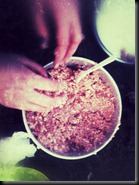This post runs in the vein of using mobile devices in the classroom. Not all school are forward thinking enough to allow pupils’ own devices in to school, but what’s stopping teachers? Many teachers at our institution now have access to a smart phone and through meeting many other geography teachers, it’s clear that many of them have them also!
I’m a great believer in taking (ir)responsible action before asking permission so this post aims to highlight my iPhone set up and the Apps that are used quite often in class. It is by no means a complete list of what I use and it’s in no way organised. I haven’t included prices etc.. It’s a sort or update of this 2010 post.
The home screen has access to a few Apps that I find essential for teaching:
Evernote – take notes of anything, save them in the cloud, access them on any computer with internet access, include pictures, audio, video…. Used mainly for, erm, taking and making notes. For example, our Curriculum Briefings that take place on a Wednesday are jotted down here and then emailed to the team.
Posterous – Mainly used for keeping my Photo Blog updated. Priory Geography used this app with great effect for live blogging during fieldwork. Again, easy to upload photos, videos etc. I know that Twitter has acquired the site, but it’s free at the moment. We also use Posterous for creating and maintaining secret project blogs e.g. DiGITAL LEADERS and or Mobile Project.
Qrafter Pro – Our QR Code thingy of choice
Most of the other Apps are mainly for personal use, although there are obvious links to the classroom. I mainly use the Twitter app in class for sharing examples of good work and Google is there to provide me easy access to Reader on the move.
Documenting learning and projects is important as is producing quality photographs. Although the iPhone (and iPad) camera are limited, these Apps can make passable images possible.
One of my favourite Apps is Microsoft’s Photosynth. If, like me, you don;t want to take a billion photographs then upload them to the real version of the App then this is for you. It’s very easy to create useful 360 degree interactive images of any area. Ideal for fieldwork prep and follow-up work in the classroom.
Snapseed is a recent favourite of mine. It’s a nifty photo editor that produces good results.

Which brings us to the Mobile Proj folder.
Dropbox contains Priory Geography’s entire curriculum as well as my own personal images and files. More on that here.
Geocaching is an ‘expensive’ App but well worth it. Used mainly in my own time with my toddler and when in the high mountains with a 28 year old toddler, recently used for the Olympic Geocaching project.
Microsoft’s TAG is a useful QR Code type featured software. Also used during the Olympic Geocaching Project.
Skydrive allows access to online files while OneNote is brilliant. Very much like Evernote but with a more familiar Office feel. We use it extensively for students to collaborate with each other via Priory Geography’s account. Also great for setting tasks. Both of these apps are very useful and I’d reconmend you have an explore. Finally Audioboo is a useful way to record sounds in a location if you want to share them.






Comments
Post a Comment